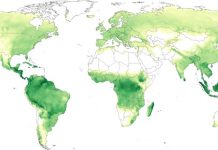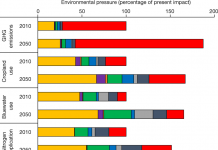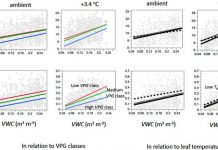【早期维管植物对陆地的修饰 】Jinzhuang Xue et al. Belowground rhizomes in paleosols: The hidden half of an Early Devonian vascular plant. PNAS 2016 doi: 10.1073-pnas.1605051113
Abstract
The colonization of terrestrial environments by rooted vascular plants had far-reaching impacts on the Earth system. However the belowground structures of early vascular plants are rarely documented and thus the plant−soil interactions in early terrestrial ecosystems are poorly understood. Here we report the earliest rooted paleosols (fossil soils) in Asia from Early Devonian deposits of Yunnan China. Plant traces are extensive within the soil and occur as complex network-like structures which are interpreted as representing long-lived belowground rhizomes of the basal lycopsid Drepanophycus. The rhizomes produced large clones and helped the plant survive frequent sediment burial in well-drained soils within a seasonal wet−dry climate zone. Rhizome networks contributed to the accumulation and pedogenesis of floodplain sediments and increased the soil stabilizing effects of early plants. Predating the appearance of trees with deep roots in the Middle Devonian plant rhizomes have long functioned in the belowground soil ecosystem. This study presents strong direct evidence for plant−soil interactions at an early stage of vascular plant radiation. Soil stabilization by complex rhizome systems was apparently widespread and contributed to landscape modification at an earlier time than had been appreciated.
一项研究发现,来自一种早期维管植物的痕量的保存下来的植物物质提供了亚洲最早的有根的土壤床的证据。维管植物在陆地地形上的定植影响了大气和地质过程, 但是早期维管植物的地下结构在化石记录中的有限的呈现导致了对早期陆地生态系统的植物-土壤相互作用的不完整的理解。Jinzhuang Xue及其同事研究了来自中国云南的一个地质地层的年代测定为大约4.11亿年到4.08亿年前的早泥盆纪时期的河流沉积物样本。在这些土壤沉积物样本 中,这组科研人员发现了复杂的网络样结构,类似于一组已灭绝的早期维管植物的地下根状茎。使用土壤形态学和地球化学对这些沉积物样本进行的分析表明这些植 物材料很可能增加了土壤稳定性并且对该地区的土壤积累和形成有贡献。这组作者说,这些早期植物标本早于泥盆纪中期的深根树的出现,这提示维管植物的这些地 下结构可能在早期陆地生态系统中出现,而在维管植物陆地定植的一个早期阶段的植物-土壤相互作用对地球景观修饰的贡献可能比此前认为的更早。(来源:EurekAlert!)
【四角地区的甲烷排放】Christian Frankenberg et al. Airborne methane remote measurements reveal heavy-tail flux distribution in Four Corners region. PNAS 2016 doi: 10.1073-pnas.1605617113
Abstract
Methane (CH4) impacts climate as the second strongest anthropogenic greenhouse gas and air quality by influencing tropospheric ozone levels. Space-based observations have identified the Four Corners region in the Southwest United States as an area of large CH4 enhancements. We conducted an airborne campaign in Four Corners during April 2015 with the next-generation Airborne Visible-Infrared Imaging Spectrometer (near-infrared) and Hyperspectral Thermal Emission Spectrometer (thermal infrared) imaging spectrometers to better understand the source of methane by measuring methane plumes at 1- to 3-m s







